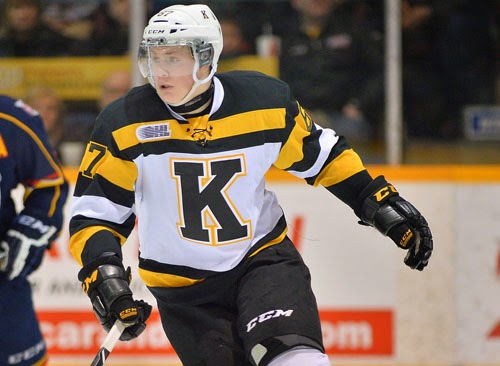One of the best hockey articles I have ever read was Tyler Dellow’s piece on the big mistake. I’m sure you have all seen this quote before but let me show it again.
“If someone asked me what I think the biggest failing of the eyeball test is, I’d respond that it’s the emphasis on the big mistake. There are gigabytes of information contained in a hockey game. So much information that I think it’s difficult for anyone to take it in and organize it rationally. The way that our brains deal with that is by focusing on the big mistake.”
Now unfortunately with his site going dark we don’t have access to that post anymore so I don’t remember if he mentioned this or not. But I think the idea of the big mistake works the same way as the big play.
Twitter was pretty active Wednesday when Damion Cox of Sportsnet came out with his Top 30 draft rankings and had Lawson Crouse 4th. This is the same Crouse who has just 0.67 ppg in the OHL this season. This ranking is by no means out of the blue, every major scouting site has Crouse this high.
What got me thinking is that people have said when they watch Crouse he looks amazing, which is something I understand. When I have watched Crouse he has looked pretty good by my eye test.
But you have to ask yourself what did he do to look good. Well my notes have him as a great skater, big body, physical, lots of hits, big time PK guy, all good things no doubt about it. Think about those plays though what do they all have in common? There are three things: first they happen every game, second they don’t require the puck in anyway, and third they tend to be memorable plays.
When a scout goes to a game he is always going to see Crouse’s large frame, his good skating, he’s always going to play physical and likely be killing penalties. Those attributes are never going to change. Crouse isn’t going to randomly shrink for a game, and he is not going to forget how to skate. He may play a less physical game at times but still likely throws some hits. He may not kill penalties in every game but more often than not he’s going to be out there.
He doesn’t need the puck on his stick to show off those attributes. When scouts attend a game they’re more watching individual players than the game itself. So it would be very easy to notice all of Crouse’s abilities early and often in the game. This is where confirmation bias kicks in. You go into a game knowing Crouse is highly thought of, and see him early in the game show off all his tools. All Crouse has to do at this point is make a big play; whether that be a big hit, a fight or a blocked shot and that person is going to walk away thinking Crouse had a monster game.
The type of plays Crouse commonly makes (hits, fights, blocks) I find to be, outside of goals, some of the more memorable moments from a hockey game. I did some quick research on memory and came across a few reasons as to why that may be: Beliefs, Relevance, and Subconscious. Your beliefs play a big part of your memory. So if you believe that hits and blocked shots are what help win hockey games, you’re likely to remember those plays more. That belief makes those plays more relevant which in turn makes your remember them more. Eventually you start to subconsciously omit information that you don’t find relevant.
Applying that information sheds some light on why smaller players are undervalued. Let’s take for example Dante Salituro of the Ottawa 67’s. He’s very small (5’08, 178lbs), but is incredibly skilled (33 points in 30 games). He does a lot of things very well offensively, such as getting controlled zone entries and generating shot attempts. He has eight games this season where he has failed to register a point and 12 where he’s failed to score. That’s over 25% of his games where he didn’t make a big or memorable play. The belief in those games would be he didn’t impact the game in anyway. It’s obvious that the NHL still values hits and blocked shots highly so the plays Salituro makes come off as irrelevant and thus forgotten.
Scouting is still very much an eye-ball game. NHL teams need to be aware of the tendencies and bias that their scouts have. Front offices are becoming much smarter and should be aware of these tendencies and biases. They need to teach their scouts what to look for and how to evaluate players in today’s NHL. Until that happens smaller players are going to continue to be undervalued and players like Lawson Crouse are going to picked in the top 5.
Follow me on twitter @PaulBerthelot
Add The Sports Daily to your Google News Feed!
